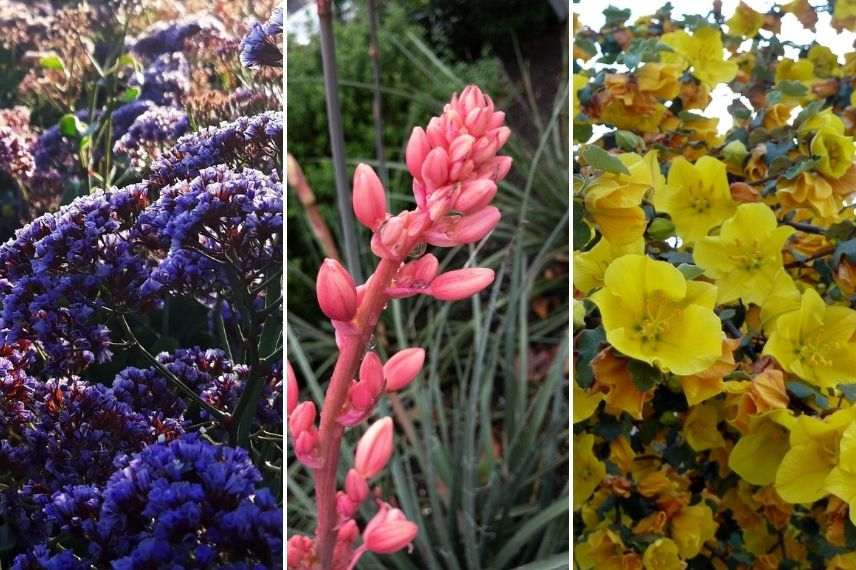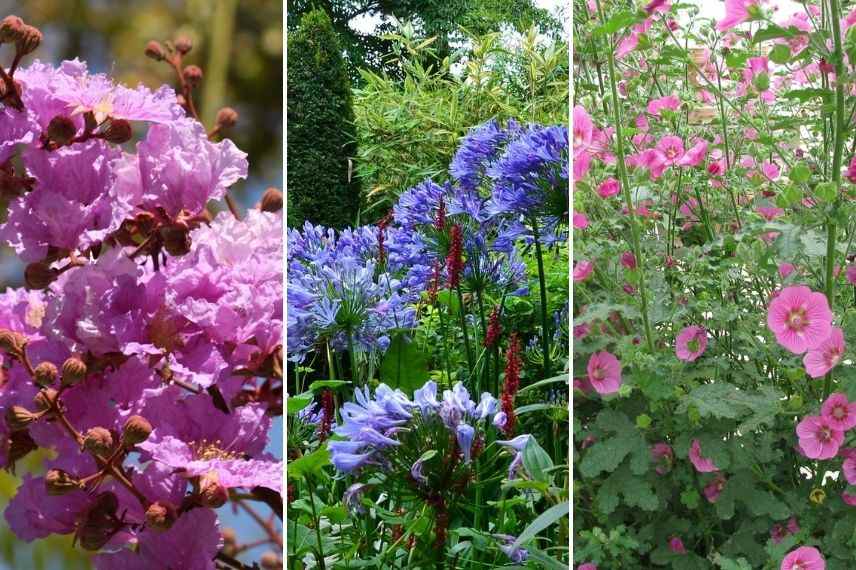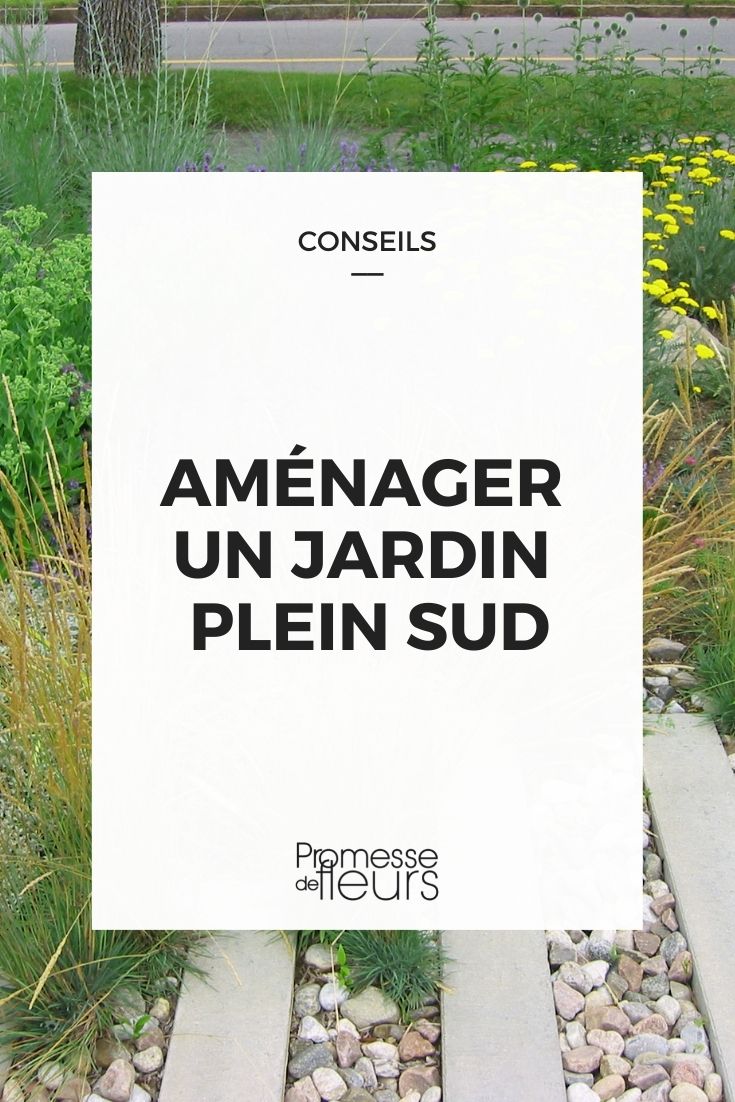
Plants and advice for a South-facing garden
Our best tips to benefit from a South-facing exposure in the garden
Contents
A south-facing garden is a boon for all slightly tender plants that need plenty of light and can withstand drought. A full south garden is not just a garden by the Mediterranean, and often, even north of the Loire in France, you can grow most Mediterranean plants. Discover our tips to enjoy a beautiful south-facing garden, no matter your region.
To avoid any failures, we advise you to plant appropriately; don’t hesitate to adopt our web application Plantfit.
What does full South mean: advantages and disadvantages?
What does “full south” really mean?
In the garden, plants need to capture light and warmth. An appropriate orientation of your garden will ensure optimal growth and better productivity in the vegetable patch. Many experts recommend a north-to-south orientation so that plants benefit from a homogeneous and prolonged exposure to sunlight. When positioned towards the west, plants tend to shade themselves.
Advantages and disadvantages
Full south corresponds for most plants to 6 to 8 hours of sunlight per day. For species that may not be able to withstand hours of harsh sun exposure, we recommend placing them so that they receive morning sun and afternoon shade. Most climbing plants are a very good alternative for a southern exposure. Finally, this exposure allows for the cultivation of Mediterranean plants even in the north of the Loire, as some are quite hardy.
Southern exposure is ideal in spring for early flowering and also a blessing in autumn for bulbs like yellow crocuses Sternbergia lutea. They will bloom abundantly from September, while in the shade, they will have to wait more than a month. A southern exposure in the garden brings much satisfaction.
Full south exposure should be approached with caution in summer, especially in Mediterranean regions. Only plants suited to prolonged dry periods should be planted without protection; others will need to be mulched at their base.
Read also
7 trees for a South-facing gardenWhich plants to choose according to your region?
For Mediterranean climate regions
Hot, dry summers and mild winters. You should choose Mediterranean plants that can withstand long months of summer drought, exacerbated by a drying mistral wind. Although Mediterranean plants seem suitable for all regions, they can be used under certain conditions, selecting well-exposed and sheltered locations to protect them from winter frosts. In the garden, a sheltered area by a structure can accommodate these less hardy plants.
Here is our selection to discover:
- Bush sages: The all-terrain champions of summer flowering: they start blooming in May and continue until the first frosts. They come in all colours, from white to red, including Tyrian pink, salmon, and candy pink.
- Hesperaloe: This perennial, still underused, deserves to be more widely known. It has fine, hard, blue-green rosette leaves. In summer, long, flexible stems bearing lovely raspberry-pink flowers emerge from the clump. Note that the plant is frost-resistant, down to -15°C in well-drained soil.
- Mediterranean heathers: Very common from the Iberian Peninsula to Italy. It is recognised by its flowers with stamens exceeding the corolla, grouped at the ends of flowering branches. It blooms in late summer, in dry, neutral, or even slightly calcareous soil. When kept dry, it withstands temperatures down to -20°C.
- Limonium: A cousin of plumbagos, it is widely used for making dried bouquets. Its flowering is very long, even without watering, as long as the flowers are picked, the plant produces new flowering stems.
- Fremontodendron californicum (California Fremontia): This bush is a true rock that adapts to salt spray, drought, and pollution!

Native to North America, in the centre is Hesperaloe and to the right is Fremontodendron. On the left is the Canary statice.
For oceanic climate regions
Influenced by the presence of the Atlantic Ocean, temperatures in summer and winter are mild but variable. Some summers can be scorching. Therefore, you can choose less hardy plants of Mediterranean or southern origin.
Here is our selection to discover:
- Eschscholzia californica or California poppy: 30 to 40 cm tall, it produces large white, yellow, or orange cup-shaped flowers. Sow in place from February to May in borders and beds, then thin out. The California poppy gives a “natural” look to gardens, but it can be invasive. It prefers well-drained, even poor soils.
- Lagerstroemia (Crape myrtle): It also adapts to extreme conditions such as drought, coastal areas, and pollution. You will be charmed by its bright pink panicles throughout the summer.
- Agapanthus: A bulbous perennial, it offers beautiful blue or white flowering stems with deciduous or evergreen foliage depending on the variety.
- Anisodontea: A beautiful shrub from the Malvaceae family, with generous purple-pink flowering from April to October and rapid growth. It can even bloom for 12 months in very mild winters. It loves sunny exposures and light, well-drained soils.

On the left, the scarlet flowering of Lagerstroemia, in the centre Agapanthus, and on the right Anisodontea.
For continental climate regions
Heatwaves are becoming more frequent and prolonged, affecting regions north of the Loire! Therefore, it is essential to learn which plants adapt to high temperatures and the drought of hot summers and long, cold, humid winters. That said, a south-facing, warmer, and sheltered exposure allows for the selection of hardy Mediterranean plants.
Here is our selection:
- Perovskia (or Afghan sage): A cousin of sages, with azure blue flower spikes and silver-grey foliage, it blooms from spring to autumn. It requires light, well-drained soil and a sunny location. It is also very hardy and fast-growing.
- Phlomis (or Jerusalem sage): A perennial with long pale yellow flower spikes. Hardy, it prefers light, poor soils, even calcareous. Its fragrant foliage persists in winter.
- Potentilla: A shrubby plant resembling a wild rose. It produces yellow, orange, pink, or red flowers all summer. It is a very accommodating plant that thrives in both poor or rich, dry or moist soils, and full sun. Very hardy down to -25°C, it requires no special attention other than a little pruning to maintain a compact habit.
- Gaura: Particularly appreciated in urban areas for its resistance to pollution, Gaura adds a rustic touch to your beds and will brighten your garden from spring to autumn.
- Erigerons: These small flowers grow everywhere: in the crevice of an old wall, at the edge of a bed… Erigeron is remarkably resilient.
Discover also drought-resistant shrubs.
 On the left, Phlomis or Jerusalem sage, in the centre, the fleabane Erigeron; on the right, the yellow potentilla.
On the left, Phlomis or Jerusalem sage, in the centre, the fleabane Erigeron; on the right, the yellow potentilla.
When and how to plant?
What is the best time to plant?
Plant in early autumn, so that they have time to settle in before winter and are better equipped to withstand drought the following year.
How to plant?
- Prepare your soil: Before planting, remove large stones and turn your soil, adding fertiliser (such as manure);
- Mulch: Mulching is the best way to protect the root system from extreme weather conditions. A mineral mulch will capture heat in a humid climate. An organic mulch will prevent water loss and the germination of dormant seeds in the soil. This reduces the need for weeding and frequent watering.
- Shield from wind: Sunny locations are often exposed areas. They generally allow access to strong winds that can drop temperatures by several degrees. Create sheltered zones for delicate plants by installing windbreak hedges.
- Plant young: Choose young plants and ensure their roots have not formed bundles; this will help them establish better. Don’t hesitate to use plants from local cuttings or sowings. This avoids thermal shocks that a plant might have experienced in a greenhouse.
- Plant on raised beds. Mounds and other raised cultures warm up quickly in early spring. They ensure good drainage, which is crucial for the most delicate plants.
- Water generously. Watering should be spaced out but plentiful in the months following planting to allow all your plants to establish well. This encourages plants to root deeply, which is a good strategy for their development against the effects of drought and frost. Wind dries out the garden just as much as the sun.
- Subscribe!
- Contents
































Comments